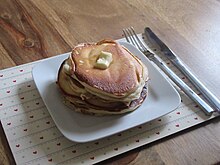
A pancake is a flat cake, often thin and round, prepared from a starch-based batter that may contain eggs, milk and butter and cooked on a hot surface such as a griddle or frying pan, often frying with oil or butter. It is a type of batter bread. Archaeological evidence suggests that pancakes were probably eaten in prehistoric societies.

A griddle, in the UK typically referred to simply as a frying pan or flat top, is a cooking device consisting mainly of a broad, usually flat cooking surface. Nowadays it can be either a movable metal pan- or plate-like utensil, a flat heated cooking surface built into a stove or kitchen range, or a compact cooking machine with its own heating system attached to an integrated griddle acting as a cooktop.

A scone is a traditional British baked good, popular in the United Kingdom and Ireland. It is usually made of either wheat flour or oatmeal with baking powder as a leavening agent, and baked on sheet pans. A scone is often slightly sweetened and occasionally glazed with egg wash. The scone is a basic component of the cream tea. It differs from teacakes and other types of sweets that are made with yeast. Scones were chosen as the Republic of Ireland representative for Café Europe during the Austrian presidency of the European Union in 2006, while the United Kingdom chose shortbread.

A muffin is an individually portioned baked product; however, the term can refer to one of two distinct items: a part-raised flatbread that is baked and then cooked on a griddle, or a quickbread that is chemically leavened and then baked in a mold. While quickbread "American" muffins are often sweetened, there are savory varieties made with ingredients such as corn and cheese, and less sweet varieties like traditional bran muffins. The flatbread "English" variety is of British or other European derivation, and dates from at least the early 18th century, while the quickbread originated in North America during the 19th century. Both types are common worldwide today.
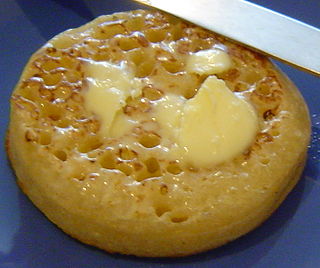
A crumpet is a small griddle bread made from an unsweetened batter of water or milk, flour, and yeast, popular in the United Kingdom, Canada, New Zealand, South Africa and Australia.

A blini, traditionally also called a blin is a Russian and more broadly Eastern European pancake made from various kinds of flour or buckwheat, wheat, etc. They may be served with smetana, tvorog, caviar and other garnishes, or simply smeared with butter. Blini are among the most popular and most-eaten dishes in Russia.

Pennsylvania Dutch cuisine is the typical and traditional fare of the Pennsylvania Dutch. According to one writer, "If you had to make a short list of regions in the United States where regional food is actually consumed on a daily basis, the land of the Pennsylvania Dutch—in and around Lancaster County, Pennsylvania—would be at or near the top of that list," mainly because the area is a cultural enclave of Pennsylvania Dutch culture.

Boxty is a traditional Irish potato pancake. The dish is mostly associated with the north midlands, north Connacht and southern Ulster, in particular the counties of Leitrim, Mayo, Sligo, Fermanagh, Longford, and Cavan. There are many recipes but all contain finely grated, raw potatoes and all are served fried.

Welsh cakes, also bakestones or pics, are a traditional sweet bread in Wales. They have been popular since the late 19th century with the addition of fat, sugar and dried fruit to a longer standing recipe for flat-bread baked on a griddle.

Potato bread is a form of bread in which potato flour or potato replaces a portion of the regular wheat flour. It is cooked in a variety of ways, including baking it on a hot griddle or pan, or in an oven. It may be leavened or unleavened, and may have a variety of other ingredients baked into it. The ratio of potato to wheat flour varies significantly from recipe to recipe, with some recipes having a majority of potato, and others having a majority of wheat flour. Some recipes call for mashed potatoes, with others calling for dehydrated potato flakes. It is available as a commercial product in many countries, with similar variations in ingredients, cooking methods, and other variables.

Johnnycake, also known as journey cake, johnny bread, hoecake, shawnee cake or spider cornbread, is a cornmeal flatbread, a type of batter bread. An early American staple food, it is prepared on the Atlantic coast from Newfoundland to Jamaica. The food originates from the indigenous people of North America. It is still eaten in the Bahamas, Belize, Bermuda, Canada, Colombia, Curaçao, Dominican Republic, Jamaica, Puerto Rico, Saint Croix, and the United States.

A tattie scone or potato scone is a regional variant of the savoury griddle scone which is especially popular in Scotland. Many variations of the recipe exist. They generally include liberal quantities of boiled potatoes, butter and salt.
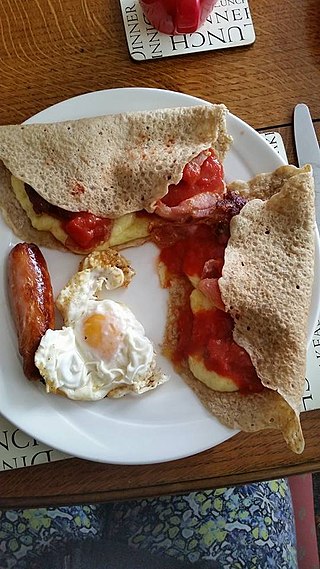
A Staffordshire oatcake is a type of dense, savoury pancake made from oatmeal, flour and yeast. It is cooked on a griddle, "backstone" or "baxton". The oatcake is a local speciality in the North Staffordshire area of England. They are normally referred to as Staffordshire oatcakes by non-locals, because they are made in and around Staffordshire and Cheshire; locally they are simply called "oatcakes".

Onion cake is a savory or sweet cake prepared using onion as a primary ingredient. Various onion cakes are consumed in Canada, China, Germany, Korea, Switzerland, Wales and other countries. Several types and varieties of onion cakes exist, including laobing, pajeon, the scallion pancake, Edmonton-style green onion cake, teisen nionod and zwiebelkuchen.
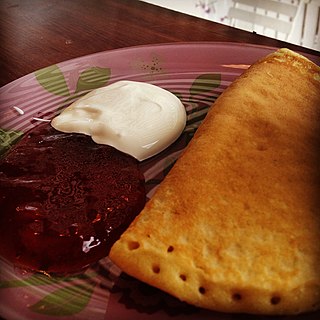
Svele, also known as lapp, is a Norwegian batter-based cake. By size and texture they may bear some resemblance to American pancakes, but are usually eaten for afternoon coffee or as a snack between meals, served with butter and either sugar or brunost, folded in half to the shape of a crescent. Baking soda and salt of hartshorn are used as rising agent in svele, which give this cake its characteristic flavour. Recipes may differ slightly according to region or to house recipes, but usually include egg, sugar, kefir, wheat flour, and butter in addition to the above-mentioned rising agents. The svele is fried on a griddle or in a lightly buttered frying pan.
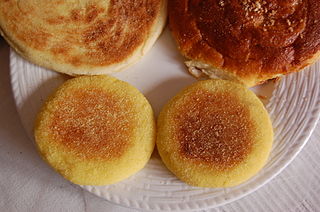
Harcha is a griddle- or pan-cooked semolina flatbread native to the Middle Atlas in Morocco, and also found in Algeria.
The coast of Ceredigion is made up of a long coastal plain that contains high cliffs, coves, large bays and estuaries. The coastal plain gets narrower towards the more mountainous north of the county and is cut by the wide estuaries of the Teifi and the Dyfi. The broad and fertile Teifi valley is ideal for dairy farming and mixed farming. Heavy rainfall washes the minerals out of the soil and results in the mountainous areas of the county having relatively poorer, acidic soils. The plough line can be as low as 700 feet, which restricts cultivation.

The cuisine of Monmouthshire is historically associated with Lady Augusta Hall, who was also known as Lady Llanover. Lady Llanover published one of the first Welsh cookery books called First Principles of Good Cookery. The book uses a fictional Welsh hermit to give culinary advice to a visiting guest who is travelling though Wales.

The cuisine of the Vale of Glamorgan, Wales, is noted for its high-quality food produced from the fertile farmland, river valleys and coast that make up the region. The area has a long history of agriculture that has developed from the Roman era.
